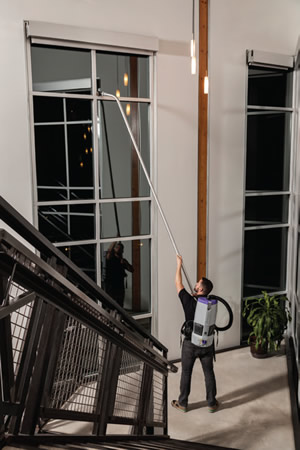Healthy Green Cleaning at IUPUI

With ProTeam backpack and cordless vacuums, the custodial staff at Indiana University–Purdue University was able to clean 6,000 to 7,000 square feet per hour of the university’s 4.5 million square feet.
In the heart of Indianapolis, Indiana’s premier urban research university educates about 31,000 students. The campus of Indiana University–Purdue University Indianapolis (IUPUI) consists of 70 buildings with 4.5 million square feet of space. Building Operations Manager Jim Walsh and his team spent the last six years advancing IUPUI toward green, high-performance cleaning equipment and practices, including ProTeam backpack and cordless vacuums.
Walsh set out with specific goals toward becoming more sustainable. He wanted to improve Indoor Air Quality (IAQ), create healthier buildings and, subsequently, reduce employee and faculty turnover. To address IAQ, Walsh and his supervisors finally convinced their reluctant staff to use ProTeam backpack vacuums with advanced filtration to capture many allergens and asthma triggers.
IUPUI had backpack vacuums in the custodial closet in 2008 when Walsh started, but less than 20 percent of the staff used them. Then Walsh observed that backpack vacuums clean about 6,000 to 7,000 square feet per hour compared to 1,500 to 2,000 square feet with upright vacuums. ProTeam backpack vacuums are also certified by Carpet and Rug Institute and in line with LEED requirements, which many IUPUI buildings follow. After some education and training, management converted the entire campus to ProTeam backpacks.
Walsh also invested in about 20 units of the ProTeam cordless backpack vacuum, the GoFree Flex Pro, for cleaning stairwells and entry matting during the day. Walsh also needed them in areas without outlets, such as the enclosed walkways that connect several campus buildings. In general, cordless vacuums improve speed and maneuverability by removing the restriction of a cord and eliminating cord management tasks.
“Vacuum cords created a trip hazard for the cleaner in stairwells,” says Walsh. “We’ve been moving to the battery-operated ProTeam backpack vacuums for stairwells. It promotes better safety.”
www.proteam.emerson.com
This article originally appeared in the College Planning & Management October 2018 issue of Spaces4Learning.